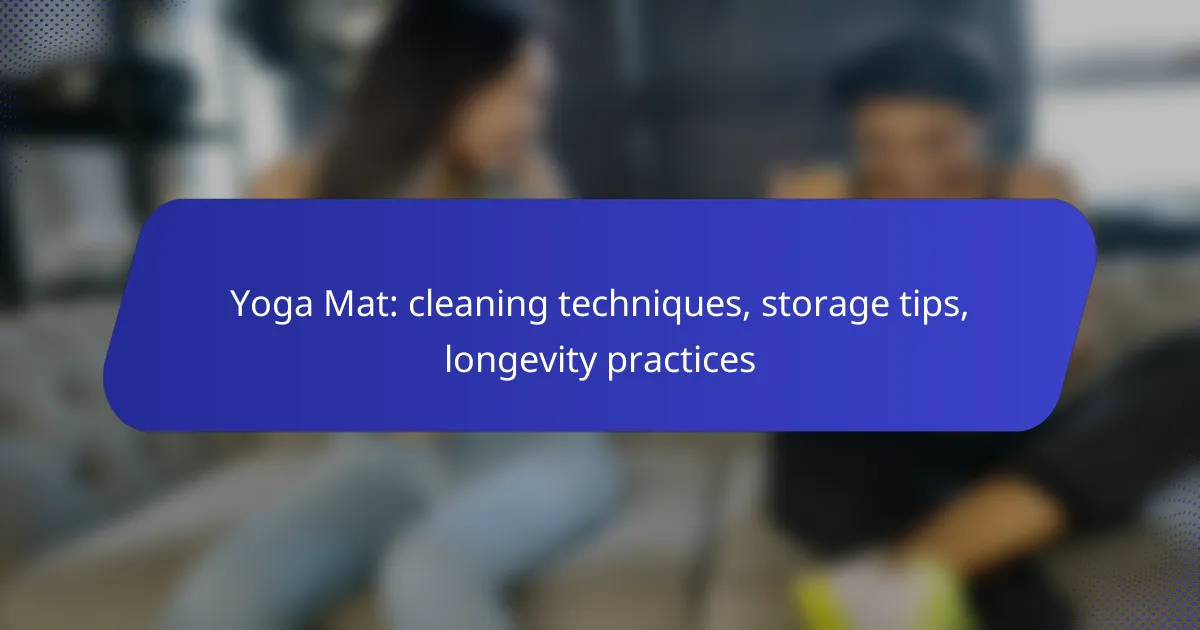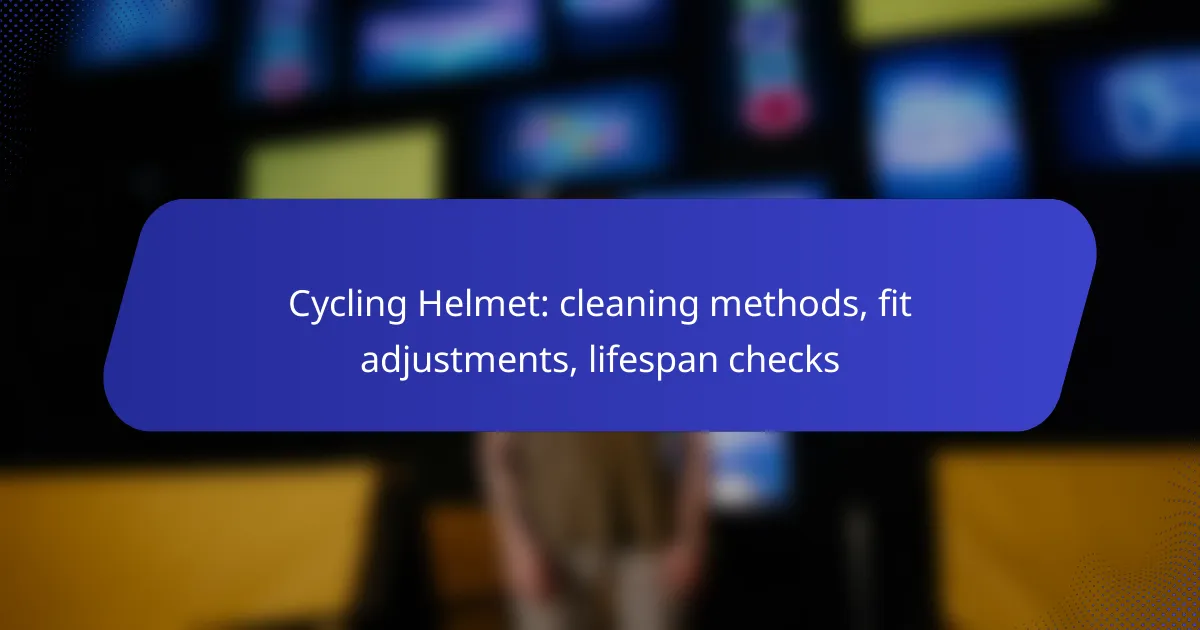Maintaining your yoga mat is crucial for both hygiene and longevity. Regular cleaning, proper storage, and mindful usage can significantly enhance its lifespan and ensure a safe practice environment. By adopting effective techniques, you can protect your investment and enjoy a more pleasant yoga experience.

How to clean yoga mats effectively?
Cleaning yoga mats effectively involves using appropriate methods and solutions to maintain hygiene without damaging the material. Regular cleaning helps extend the life of the mat and ensures a safe practice environment.
Use natural cleaning solutions
Natural cleaning solutions are gentle on yoga mats and effective in removing dirt and odors. A simple mixture of water and vinegar or a few drops of essential oils in water can serve as an excellent cleaning agent.
When using these solutions, spray lightly on the mat and wipe with a soft cloth. Avoid harsh chemicals, as they can degrade the mat material over time.
Machine wash options
Some yoga mats are machine washable, making cleaning convenient. Check the manufacturer’s instructions to confirm if your mat is suitable for machine washing.
If allowed, wash the mat on a gentle cycle with cold water and mild detergent. Always air dry the mat afterward, as heat can warp the material.
Hand washing techniques
Hand washing is a reliable method for cleaning yoga mats, especially those not suitable for machines. Use a soft sponge or cloth with a mixture of warm water and a mild soap to scrub the surface gently.
Rinse thoroughly with clean water to remove any soap residue, as leftover soap can make the mat slippery during use.
Frequency of cleaning
Cleaning frequency depends on usage; generally, mats should be cleaned every few uses. If you practice frequently or sweat a lot, aim for cleaning after every session.
For less frequent users, a deep clean every few weeks is usually sufficient to maintain hygiene and freshness.
Drying methods
Proper drying is crucial to prevent mold and odors. After cleaning, hang the mat in a well-ventilated area away from direct sunlight, which can cause fading or damage.
Avoid folding or rolling the mat until it is completely dry to ensure moisture does not get trapped, leading to potential mildew growth.

What are the best storage tips for yoga mats?
Proper storage is essential for maintaining the quality and longevity of yoga mats. By using effective storage techniques, you can prevent damage, warping, and degradation over time.
Vertical storage solutions
Storing yoga mats vertically is one of the best ways to keep them in good condition. This method prevents creasing and allows for better air circulation. Consider using a dedicated mat rack or simply leaning the mat against a wall in a dry area.
If you have multiple mats, a vertical storage solution can save space and make it easier to access each mat when needed. Ensure that the area is clean and free from moisture to avoid mold growth.
Using yoga mat bags
Yoga mat bags provide a convenient way to store and transport your mat while protecting it from dust and dirt. Look for bags made from breathable materials to prevent moisture buildup. Many bags also come with additional pockets for carrying accessories like straps or towels.
When choosing a mat bag, consider the size and thickness of your mat to ensure a proper fit. A well-fitted bag can help maintain the mat’s shape and integrity during storage.
Avoiding direct sunlight
Direct sunlight can cause significant damage to yoga mats, leading to fading and material degradation. Store your mat in a shaded area or inside a bag to shield it from UV rays. If you practice outdoors, roll up your mat immediately after use to minimize exposure.
Consider using a mat with UV-resistant materials if you frequently practice in sunny environments. This can help prolong the life of your mat while maintaining its appearance.
Temperature considerations
Temperature plays a crucial role in the longevity of yoga mats. Extreme heat can cause materials to warp, while cold temperatures may make them brittle. Aim to store your mat in a climate-controlled environment, ideally between 15°C and 25°C (59°F to 77°F).
Avoid leaving your mat in a hot car or near heat sources, as this can lead to irreversible damage. If you live in a region with significant temperature fluctuations, consider using a protective cover for added insulation.

How to extend the longevity of yoga mats?
To extend the longevity of yoga mats, regular cleaning, proper storage, and mindful usage are essential. Implementing these practices can significantly enhance the lifespan and performance of your mat.
Regular maintenance practices
Cleaning your yoga mat after each use is crucial for maintaining its integrity. Use a gentle soap solution or a specialized mat cleaner, and wipe it down with a soft cloth. Allow it to air dry completely before rolling it up.
Additionally, deep clean your mat every few weeks by soaking it in a bathtub with warm water and a mild detergent. Rinse thoroughly and hang it to dry, avoiding direct sunlight to prevent material degradation.
Choosing high-quality materials
Selecting a yoga mat made from durable, high-quality materials can greatly influence its lifespan. Look for mats made from natural rubber, TPE, or eco-friendly PVC, as these tend to withstand wear and tear better than cheaper alternatives.
Consider the thickness and texture of the mat as well. A thicker mat provides more cushioning and support, while a textured surface can enhance grip, reducing the likelihood of damage from slips and falls.
Proper usage guidelines
Using your yoga mat correctly can help prevent premature wear. Avoid using it on rough surfaces, as this can cause scratches and tears. Instead, practice on smooth, clean floors to maintain the mat’s condition.
Be mindful of the types of activities you perform on the mat. High-impact exercises or practices involving heavy equipment can lead to faster degradation. For these activities, consider using a dedicated mat designed for more rigorous use.

What are the common materials used in yoga mats?
Yoga mats are typically made from a variety of materials, each offering distinct benefits and drawbacks. The most common materials include natural rubber, PVC, and TPE, each catering to different preferences and practices.
Natural rubber mats
Natural rubber mats are made from the sap of rubber trees, providing excellent grip and cushioning. They are biodegradable and eco-friendly, making them a popular choice for environmentally conscious yogis.
However, they can be heavier and may have a distinct smell when new. It’s essential to check for certifications like OEKO-TEX to ensure they are free from harmful chemicals.
PVC mats
PVC mats are made from polyvinyl chloride, known for their durability and affordability. They offer good traction and are easy to clean, making them suitable for various types of yoga.
On the downside, PVC is not biodegradable and can release harmful chemicals during production. Look for mats labeled as phthalate-free to minimize health risks.
TPE mats
TPE mats are made from thermoplastic elastomer, a newer material that combines the benefits of rubber and PVC. They are lightweight, eco-friendly, and free from toxic chemicals, making them a safe choice for yoga practice.
While they may not provide the same level of grip as natural rubber, TPE mats are often more affordable than high-end rubber options. Regular cleaning and proper storage can enhance their longevity.

How does climate affect yoga mat care in Canada?
In Canada, climate significantly influences how to care for yoga mats, particularly due to varying humidity and temperature levels across seasons. Proper maintenance practices can extend the life of your mat and ensure it remains hygienic and functional.
Humidity considerations
High humidity can lead to mold and mildew growth on yoga mats, especially if they are stored in damp areas. To combat this, ensure your mat is completely dry before rolling it up and consider using a breathable storage bag to allow air circulation.
In contrast, low humidity can cause mats to dry out and crack. Regularly applying a small amount of mat conditioner or using a damp cloth to wipe down your mat can help maintain its flexibility and prevent damage.
Cold weather storage
During the cold months, it’s essential to store your yoga mat in a warm, dry place to prevent it from becoming brittle. Avoid leaving it in a car or near windows where it can be exposed to freezing temperatures.
For optimal storage, consider keeping your mat in a closet or a dedicated yoga bag inside your home. This protects it from extreme cold and helps maintain its integrity, ensuring it remains ready for use when you need it.

What are the emerging trends in yoga mat technology?
Emerging trends in yoga mat technology focus on sustainability, performance, and user customization. Innovations include the use of eco-friendly materials, enhanced grip features, and mats designed for specific styles of yoga.
Eco-friendly materials
Eco-friendly materials in yoga mats are gaining popularity as consumers become more environmentally conscious. Common materials include natural rubber, jute, and TPE (thermoplastic elastomer), which are biodegradable and free from harmful chemicals.
When choosing an eco-friendly mat, consider factors like durability and grip. Natural rubber mats, for example, provide excellent traction but may require more care to maintain their longevity. TPE mats, while lighter and easier to clean, may not offer the same level of grip as rubber.
Look for certifications such as the Global Organic Textile Standard (GOTS) or OEKO-TEX, which ensure that the materials used are safe and environmentally friendly. Investing in a high-quality eco-friendly mat can enhance your practice while supporting sustainable practices.



